VFX artists at Gramercy Park Studios give racing a new twist for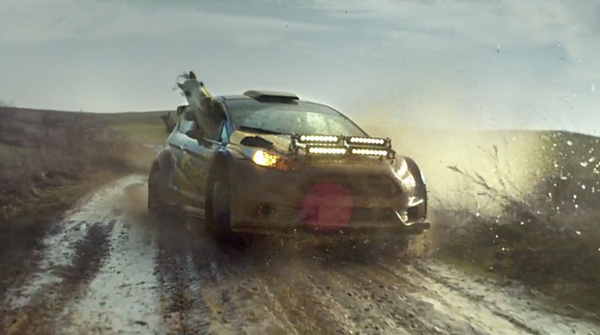
Betfair by putting race horses behind the wheel of a pair of rally
cars splashing down a country road.
Gramercy Park Raises the Stakes on Betfair’s Supercharged Horses |
| Gramercy Park Studios and agency WCRS joined forces to produce ‘This Is Play 2’, the most recent integrated campaign from Betfair. Following up on last year’s 'This is Play’ campaign, starring an acetable-tennis playing octopus, this campaign features a high-octane horse race with a twist. |
| {media load=media,id=93,width=600,align=left,display=inline} |
|
Two CamerasAlong a lonely, muddy track in the early morning light, we see three punters standing by the road, connecting to Betfair on a smart phone to place their bets on the horses. However, what the audience sees topping the crest of the road is a pair of rally cars, driven in expert racing style by two horses alongside their co-riding, jockey passengers. |
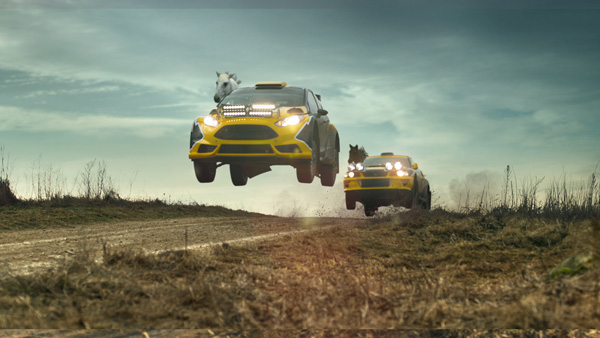 |
|
The project was shot on two cameras simultaneously – anARRI ALEXAand aPhantom high-speed camerarunning at up to 4,000 fps. The Phantom was chosen so that the editor could experiment with speed ramps in post to add drama and the illusion of speed to the footage, while the ALEXA was shooting at a more conventional frame rate, allowing the VFX team to complete the animation and tracking of the CG elements on a more manageable number of frames. VFX – Editing CollaborationWorking this way also meant that the VFX team had to be certain the edit was locked when they started compositing, so it was fortunate that Gramercy Park Studios was handling so many aspects of post production on this commercial – in particular, the editing. Nuno said, “It was fun doing it all under one roof and watching how the commercial evolved internally. Editing was handled in one suite while grading was happening in another, and all the VFX and CG was worked on at the same time at the end of the corridor. This allowed us to address any client changes in a matter of hours.” |
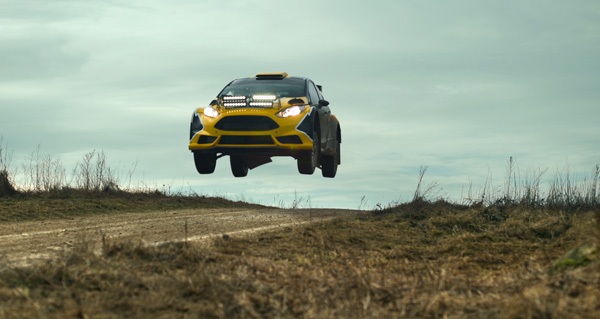 |
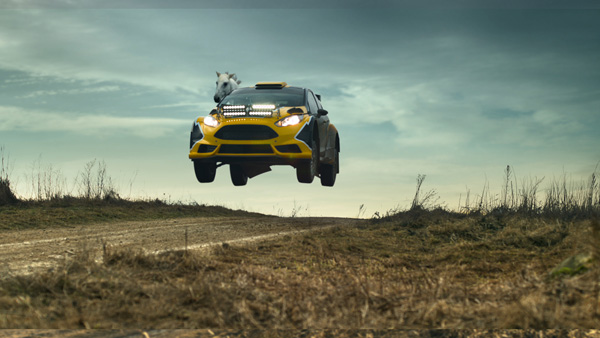 |
|
Rally CarsAt the shoot, the cars were moving quite fast. Nuno said, “Because the jump section of the road was very long and shallow, which makes the jumps more challenging, the cars had to be driven as fast as a professional rally driver could go along that road, about 80km/h or more. For safety, the whole crew had to stay behind a clearance zone of around 50 metres. Only the DP and the cameraman were allowed closer whenever the cars were running. Also, for the drivers’ safety, the cars were never driven simultaneously or racing each other as shown in the commercial. We filmed separate passes of both cars and later composited them together inFlame.” |
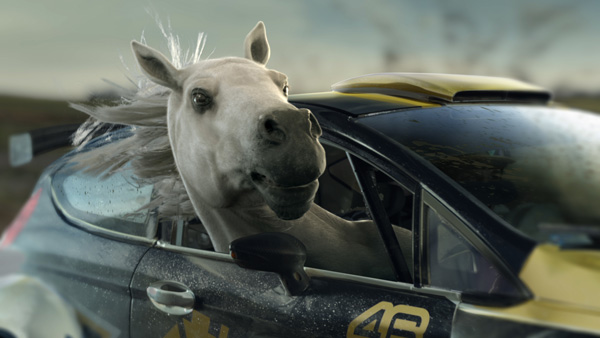 |
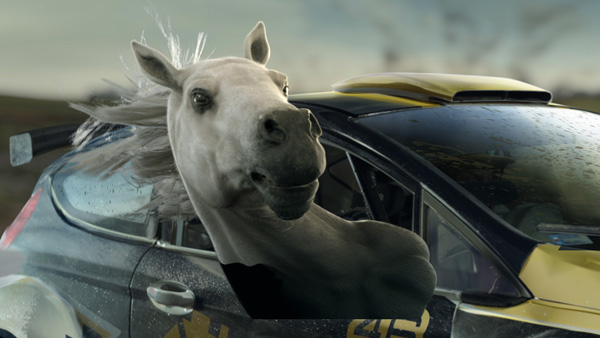 |
|
For the horses, the real stars of the spot, the director was keen to avoid a silly or cartoony look, preferring the humour to come from the contrast between their realism and the unreality of the situation. In line with that style, Nuno andVFX supervisor Mark Beardalllike to approach visual effects with techniques based on elements captured in camera. In order to maintain this approach - even for something as unreal as horses driving rally cars - the horses’ heads were created from in-camera shots of a prosthetic horse head captured at the location, combined with green screen elements of a real horse. Horse Head ModelNuno and the CG team created the horse head model and re-topology inZBrush, and then usedMayafor the 3D build and animation of the horse, and to generate texture maps. He said, “Maya was also used to create additional models, shade, animate and simulate the fur and breath. At same time, the models were processed inMarito paint fur vectors and all other texture maps. Everything was then re-assembled in Maya using our internal data management system.” |
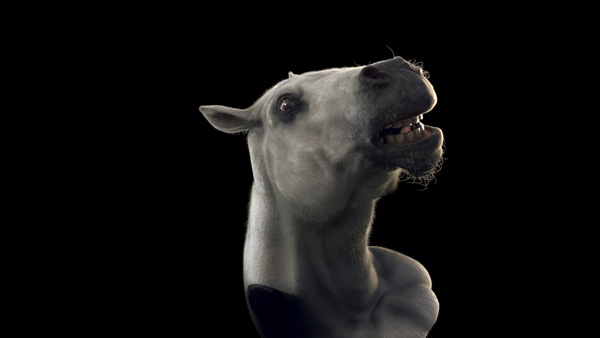 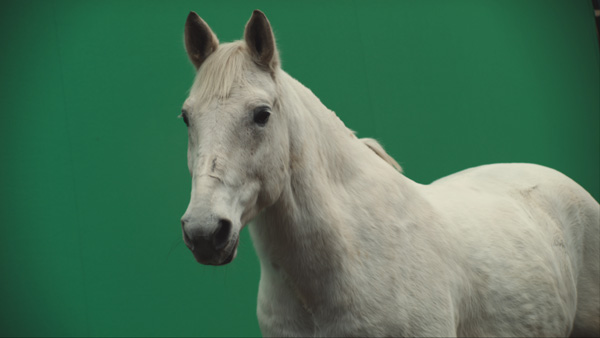 |
|
Gramercy Park’sFlame suitewas in fact the hub of the project, used for tracking shots, cleaning up and sending out shots to teams, and all of the final compositing, while NUKE was used for mattes, clean-ups and some of the sky replacements. Grand FinaleDue to location constraints and the way the director wanted to capture them, the final hero shots had to be approached differently to the rest of the team’s work on the spot. “Whereas all other shots were based on photography enhanced in compositing, the two close-ups at the end were generated completely from scratch,” Nuno said. “All elements composing these shots were captured or created separately with various techniques and then combined into one single, cohesive piece.” |
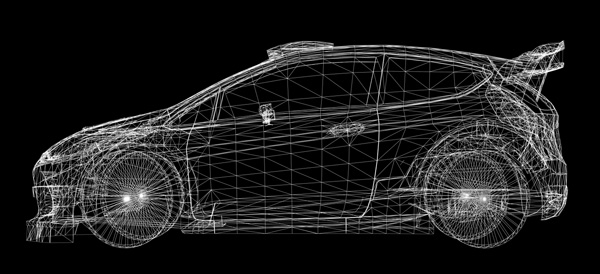 |
|
“Unlike our approach in the earlier shots, the horse head was then generated entirely in CG. Based on the prosthetic heads, we built an animatable, 3D head that could be posed to perform as the director wanted. On top we added more 3D effects to fully integrate the horse with the rest of the shot, such as breathe from the nostrils and wind on its fur,” said Nuno. Using stills taken on location, the moving background was rebuilt in 3D space so that the angle and speed could be changed as required. The car was a still frame as well. From the Flame point of view, Mark explained, “The 3D artists provided FBX geometry of the car, which was aligned to the real plate in Flame. Then we projected the still onto the 3D model and were able to relight it to match the scene as well as adding dirt, moving light and reflections. The horse was provided as passes from 3D, which were then adjusted and relit in Flame with the mane created from a combination of shot plates. Camera shake, dust and atmosphere were then added to complete the composite.” www.gramercyparkstudios.com |


















